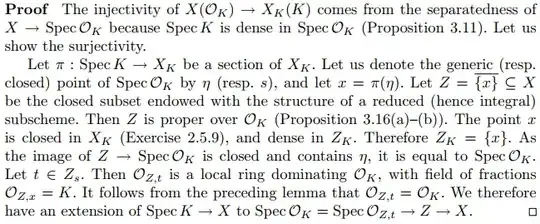I have a question about Qing Liu's proof of $X(\mathcal O_K)\rightarrow X_K(K)$. It is theorem 3.25 in his book.
Theorem 3.25. Let $X$ be a proper scheme over a valuation ring $\mathcal O_K$ and let $K = Frac(\mathcal O_K)$. Then the canonical map $X(\mathcal O_K)\rightarrow X_K(K)$ is bijective.
I struggle to understand every steps of his proof. After complicated constructions, he obtains a morphism $Spec(\mathcal O_K)\rightarrow X$ and complete the proof. But why this morphism satisfies the property we want? The construction is too strange for me and I think I'm lost somewhere.

